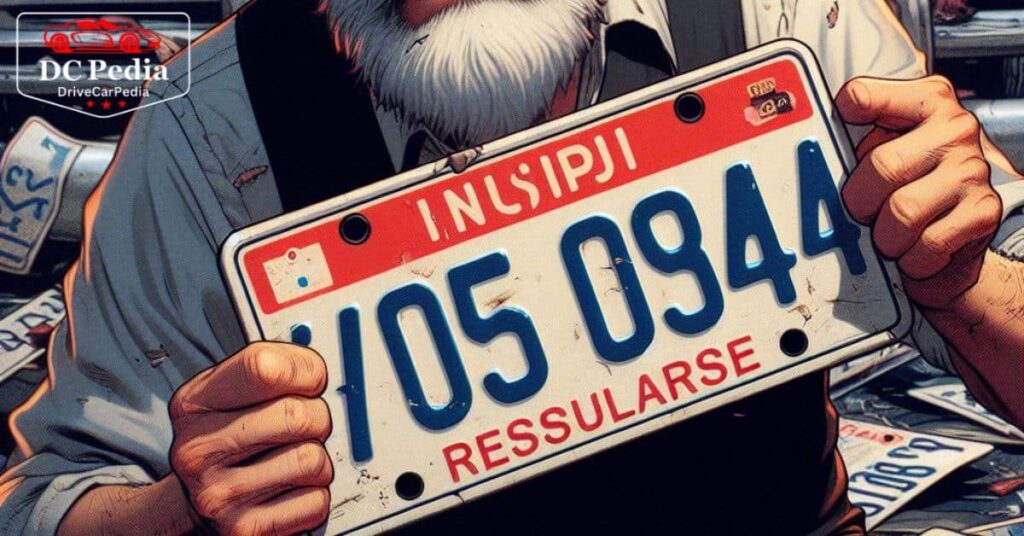Getting hit by another driver who leaves the scene can be very annoying. Fortunately, if you remember their license plate then you are not out of options. You can start by calling the police right away and reporting the incident along with the plate number. Be sure to get any witnesses involved as well to strengthen your case. Next contact your insurance company and file a claim as a hit and run.
Finally, keep notes of all details like date, time, and location in case more information is needed later to properly identify the at-fault party and make sure they are held responsible.
Defining Hit and Run
A hit and run takes place when a driver is involved in a collision but does not stop to exchange details. They try to leave the scene without providing their information to the other affected party. Such acts are considered a crime in most places.
The person fleeing tries to avoid responsibility of the crash by not stopping to handle the legal or financial obligations. Their priority is to escape from the scene without facing penalties for their negligent actions. A license plate number can be a crucial piece of evidence that allows authorities to conduct a license plate lookup to identify the owner of the vehicle.
This registration information gives police an important lead to pursue as they work to hold hit-and-run drivers accountable for abandoning the scene and any victims involved in the accident. With a plate number provided by witnesses, the driver’s attempt to flee justice may be thwarted as investigators trace the license using department databases and records.
Legal Implications of Hit and Run Incidents
If identified by police, the driver can face serious consequences under the law. Charges may include leaving the scene of an accident, failing to report or identify themselves to the other party. Harsher punishment includes jail time or license suspension if it results in injury or property damage. Proper investigation is key to building a case against those who chose to run after an accident.
Insuring one’s self from liability is important, but fleeing after an incident shows clear disregard for the safety and rights of others. Those involved in hit and runs often realize belatedly that the costs of avoiding responsibility far outweigh any temporary relief from running away.
The Role of Technology in Tracing Offenders
Modern technology plays a critical role in helping law enforcement identify and apprehend hit-and-run offenders. Surveillance cameras from buildings, traffic lights, and tollbooths can capture vehicle descriptions and license plate numbers that provide vital clues. Police also rely on traffic cameras and automatic license plate readers to narrow down the search area and potentially identify a suspect vehicle. Digital tools like vehicle records linked to license plates allow investigators to connect drivers to their registered vehicles.
The data collected from these widespread surveillance systems are also increasingly being utilized through analytical techniques. Powerful software can detect patterns to link otherwise unrelated incidents based on timeframes, locations, and other metadata. This strengthens criminal cases by demonstrating links between a discovered vehicle and the timing of a hit-and-run accident. Advanced technologies have greatly enhanced authorities’ chances of bringing justice to hit-and-run victims by aiding the pursuit of those who attempt to evade responsibility.
Here are some other ways technology is assisting criminal investigations:
- DNA databases – Law enforcement can submit DNA evidence gathered at crime scenes to databases to search for matches to known offenders. This has helped solve many cold cases.
- Surveillance cameras – Both public and private cameras in places like businesses, homes, streets, etc. can capture images and videos of suspects that aid identification.
- Cell phone records – By obtaining records from cell towers, police can track the location of phones near crime scenes to pinpoint potential suspects.
- Facial recognition – Systems are being developed and deployed to search driver’s license and other photo ID databases to identify unknown persons from images and videos.
- Drones – Police are using drones equipped with cameras to survey large crime scenes, accident sites, and assist in searches. They provide aerial perspectives.
- Social media analysis – Detectives monitor platforms to find posts, photos or videos relevant to cases that could reveal details about suspects or their activities.
- Cloud data extraction – New tools allow investigators to retrieve deleted files, messages and online activity from personal devices and accounts as potential digital evidence.
Record All Information Possible
Jot down specifics swiftly like location, time, vehicle descriptions and damages. Note license plate if visible. Seek witnesses and record their details if willing. Sign and date all collected information for the police report.
Observe and document surroundings and account of the events. Preserve any distinguishing vehicle characteristics. Provide this organized information promptly to officers. Leaving no detail unattended strengthens identification of the offender.
Reporting the Hit and Run to Police
Contact authorities or use non-emergency lines to report. Give an honest account of dates and location. Request an assessment of vehicle harm from officers. Sign a statement for their records while recalling details. Acquire a case number for proof.
Provide contact information if further evidence is required. Offer the clearest sequence of events for their files. Ask them to examine the scene for clues toward identifying the at-fault driver attempting to flee responsibility.
What to Do With the License Plate Number?
Provide the license plate number immediately to investigating officers. They can utilize databases to identify the registered owner and note any traffic violations. Request the insurance claims agent also use tracking tools through their networks.
Put authorities and insurance on the culprit’s trail to obtain compensation for damages from those at fault. This recorded information raises chances of linking the plate to the offender attempting to flee the scene.
Also Read This Blog: Can Someone Find Your Address From Your License Plate?
Final Word on Hit and Runs and License Plate Numbers
Carefully document license plates to aid authorities in their pursuit. Provide collected information promptly to increase chances of linking guilty parties to accidents. Together technology and data can work to curb these dangerous acts.
Recording license plates empowers both victims and law with critical tools to establish accountability. It sends a message that hit and runs violate driving responsibilities in society.
The Ethical and Societal Impact
Hit and runs harm more than just victims – they weaken ethical social relationships. Fleeing responsibility damages trust in the system. Witnesses coming forward upholds justice and compassion for others.
Deterring these acts protects all road users and communities. Strict laws promote high standards to safeguard lives and property. Individual testimony contributes to reforms strengthening accountable driving culture.
The Ethical Imperative and Legal Obligations
All drivers have a moral duty to assist others in emergencies according to basic ethics of human decency. Legally, hit and run statutes require stopping and providing aid or contact information to avoid charges. Accountability helps compensate victims and deters reckless acts endangering lives.
Abiding by both ethical and legal standards promotes a safe community. Fleeing accidents erodes a civil society where individuals look out for one another on the road. Strict laws paired with ethics education can curb harmful behavior over time.
How long do hit-and-run investigations take?
Investigation durations vary depending on available evidence and resources. Most hit-and-run cases that reports plates are solved within weeks as police match plates to registered owners. More complex cases lacking plates may take months to close using surveillance footage, forensic analysis and witnesses. Thorough evidence gathering improves chances of timely resolution.
The quicker a hit-and-run is reported with clear details, the faster police can begin narrowing suspect leads. Prompt community cooperation is vital to apprehend offenders and prevent escape from responsibility. Determining fault may still require court proceedings after suspect identification.
What should I do if I witness a hit and run?
Contact emergency services right away and provide any recording of license plates, vehicle descriptions and directions of travel. Safely follow at a distance if possible until authorities arrive. Give a statement about details observed including signs of impairment.
Providing timely reporting and evidence aids the victim and furthers police investigation. Circulating vehicle details on social media can also help identify suspects from public tips when plate recording wasn’t possible. Community assistance through reporting directly benefits road safety.
How to find the owner of a car involved in a hit-and-run accident?
Supply all documented details to the police who use their investigative resources and databases. Check security footage from surrounding businesses too. Occasionally the guilty party returns to the scene, so provide ongoing assistance and be vigilant for any related developments in the area.
Cooperate fully with investigators by promptly answering any follow-up questions as the inquiry progresses. Your active role supports accountability for the offender and justice for the victim harmed by this crime. Witness involvement aids resolution.
What evidence is needed to convict a hit and run?
Thoroughly collected evidence strengthens the case against the suspect. Physical evidence includes vehicle debris linking the specific cars, accident scene photos and documentation of damages. Witness reports providing consistent descriptions of the incident and vehicles enhance impact.
Suspect interrogation transcripts admitting fault or knowledge of the event provide a concession. Car maintenance records during the timeframe may also implicate a defendant if indicating recent repairs matching debris. Convictions result from building a comprehensive, corroborated case file.
How do police find hit and run drivers
Police gather witness reports including license plate numbers if seen. They enter this information into databases to match plates to owners. Officers request footage from locations hoping to spot the vehicle leaving. Interviews are conducted to find the driver’s location after the collision.
Investigators search public transportation records and conduct traffic camera analysis trying to locate the fled vehicle. Thorough evidence collection and questioning of registered owners moves the case closer to resolution.
What are charges for hit and run
A basic hit and run is usually a misdemeanor with penalties up to $1000 in fines and 6 months in jail. More serious charges like leaving the scene of an injury accident are felonies carrying higher fines up to $10,000 and several years in prison.
Additional offenses may be added depending on extent of damages or injuries caused during commission of the act. Drivers abandoning victims face the toughest sentences intended to appropriately punish disregarding victims.
What happens to hit and run drivers who are later found by their license plate?
Once identified, their vehicle is examined for matching debris or traces tying it to the scene. Police interrogate aiming to obtain confessions as these hold weight in court. Prosecutors determine charges like hit and run to bring against the driver.
If convicted, penalties over and above fines can include license suspension, restitution, probation and incarceration depending on the degree of negligence demonstrated abandoning the scene and victims.
Final Thoughts
When drivers flee the scene of an accident, witnesses must provide key details like the license plate number to law enforcement. This critical piece of evidence allows police to utilize databases and track down the registered owner. If located, the driver often faces interrogation and further investigation into linking them and their vehicle to the crime. Once identified, prosecutors determine appropriate charges and the legal process moves forward.
If convicted, penalties aim to punish the act of abandonment and deter others from leaving victims in need without assistance or accountability. While incidents end when resolved in courts, the ethical importance of responsibility and compassion continues beyond finalizing each case.



